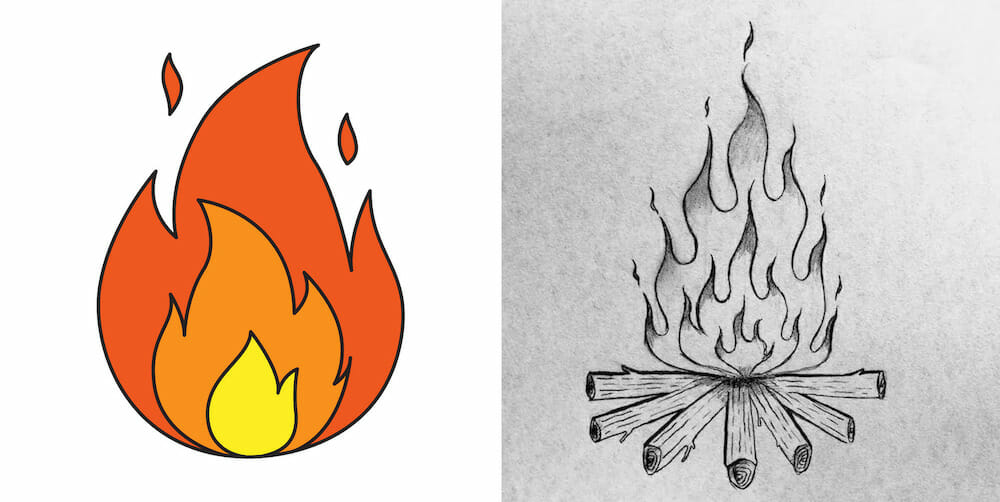Painstaking Lessons Of Tips About How Do You Make A Quick Fire

The Allure of a Quick Fire
1. Understanding the Spark
Ever found yourself needing a fire, like, right now? Whether it's for a spontaneous camping trip, a backyard barbecue that just can't wait, or, let's be honest, a primal urge to watch something burn (safely, of course!), knowing how to get a quick fire going is a valuable skill. It's not just about the flames; it's about efficiency, preparedness, and maybe a little bit of "I got this" swagger. So, forget the Boy Scout manual; let's break down the art of the quick fire in a way that even a tech-addicted millennial can understand.
At its core, creating a quick fire revolves around understanding the fire triangle: fuel, oxygen, and heat. Remove any one of these, and your dreams of toasted marshmallows vanish faster than you can say "s'more." Our focus here is on manipulating these elements to achieve ignition rapidly. Think of it as hacking fire itself. We're not looking for a slow burn; we want instant gratification in the form of crackling warmth.
Think about what makes a fire hesitant to start. Often, it's dampness, poor fuel choice, or insufficient oxygen flow. By addressing these issues preemptively, we can drastically cut down the time it takes to get a roaring blaze. It's like prepping ingredients for a gourmet meal; the better your prep, the faster and tastier the result.
Also, let's address the elephant in the room: safety. Fire is a powerful force, and respect is paramount. Always build your fire in a designated fire pit or ring, clear the surrounding area of flammable materials, and have water or a fire extinguisher readily available. A quick fire is great; a quick inferno is not. Remember, leave no trace — pack out everything you pack in and ensure the fire is completely extinguished before leaving.

How To Make A Easy Fire At Edna Sass Blog
Choosing Your Weapon
2. The Arsenal of Ignition
Think of your fire-starting materials as a tiered system. First, you've got your tinder — the easily ignitable material that catches the initial spark. Then comes your kindling — small, dry twigs and branches that take the flame from the tinder and build it into something substantial. Finally, you have your fuel wood — larger pieces of wood that sustain the fire and provide long-lasting heat. Each layer plays a crucial role in achieving a quick fire.
For tinder, think beyond newspaper. While it works in a pinch, it burns quickly and doesn't provide much heat. Better options include cotton balls soaked in petroleum jelly (a classic!), dryer lint, birch bark, or commercially available fire starters. The key is that it must be dry, fluffy, and readily flammable. Imagine you're trying to convince a stubborn spark to burst into a flame; what offering would be most irresistible?
Kindling should be dry and about the thickness of a pencil. Gather a variety of sizes, starting with twigs as thin as toothpicks and working your way up. Pine needles are also great kindling. Arrange the kindling loosely around your tinder, creating an "A" frame or a small teepee. This allows for ample airflow, which is essential for the fire to catch and grow.
For fuel wood, seasoned hardwoods like oak, maple, or ash are ideal. These woods burn hotter and longer than softwoods like pine. Make sure your fuel wood is dry; wet wood will smolder and produce a lot of smoke. If your wood is damp, try splitting it to expose the dry inner core. Remember, a successful quick fire relies on quality ingredients, just like any good recipe.

The Quick Fire Technique
3. The Ignition Sequence
Now for the main event — actually lighting the fire. Grab your preferred ignition source — matches, a lighter, or a ferro rod — and get ready to work your magic. If using matches, shield them from the wind with your body or hand. If using a lighter, hold it close to the tinder and keep it lit until the tinder catches. For a ferro rod, scrape it with a knife or striker to create a shower of sparks, directing the sparks onto your tinder.
Once the tinder catches, let it burn for a few moments, allowing the flame to establish itself. Then, gently add more kindling, being careful not to smother the flame. Blow lightly on the base of the fire to provide oxygen and encourage the flames to spread to the kindling. Think of yourself as a gentle nurturer, coaxing the fire to life.
As the kindling catches, gradually add larger pieces of fuel wood, maintaining the "A" frame or teepee structure. Ensure there's plenty of space between the logs for airflow. Avoid overloading the fire with too much fuel too quickly; this can suffocate the flames and extinguish the fire.
Patience is key. Don't expect a roaring fire to erupt immediately. Allow the fire to build gradually, adding fuel as needed. With a little practice, you'll be able to get a quick fire going in no time. And remember, the satisfaction of building a fire from scratch is a reward in itself.

Amazon.co.uk Quickfire Quiz Alexa Skills
Troubleshooting Your Quick Fire
4. Dealing with Dilemmas
Even with the best preparation, sometimes fires just don't want to cooperate. Maybe your tinder is damp, the wind is relentless, or you're just having an off day. Don't despair! Troubleshooting is part of the fire-building process. The ability to adapt and overcome is what separates a seasoned fire-starter from a frustrated camper.
If your tinder is damp, try drying it out near your body heat or in the sun for a few minutes. You can also try using a different tinder source. If the wind is blowing out your flame, create a windbreak using a rock, log, or your body. Shield the fire from the wind until it's established.
If your fire is smoking excessively, it's likely due to wet wood or insufficient airflow. Try adding smaller pieces of dry kindling to increase the heat and improve combustion. Ensure there's plenty of space between the logs for air to circulate.
If your fire refuses to catch, re-evaluate your strategy. Are you using the right tinder and kindling? Is there enough airflow? Are you providing sufficient heat? Sometimes, a simple adjustment can make all the difference. Don't be afraid to experiment and learn from your mistakes. After all, fire-starting is a skill that improves with practice.

Beyond the Basics
5. Elevating Your Flame Game
Once you've mastered the basic quick fire, you can start exploring more advanced techniques. Experiment with different types of tinder, kindling, and fuel wood. Learn how to build different fire structures, such as the log cabin or the lean-to. Explore the art of fire-starting with natural materials, such as friction fire-starting.
Consider the environment. Different environments require different fire-building strategies. In wet conditions, you'll need to be extra diligent about keeping your tinder and kindling dry. In windy conditions, you'll need to create a more robust windbreak. Adapt your approach to the specific challenges of your surroundings.
Fire-starting is a journey, not a destination. There's always something new to learn and discover. Embrace the challenge, enjoy the process, and revel in the warmth and light of your own creation. Remember, the ability to build a quick fire is not just a useful skill; it's a connection to our primal past and a source of endless fascination.
So get out there, gather your materials, and start experimenting. With a little practice and persistence, you'll be a quick fire master in no time. And who knows, maybe you'll even impress your friends with your fire-starting prowess!

Epic Rapid Fire Round Showdown! YouTube
Frequently Asked Questions (FAQs)
6. Your Burning Questions Answered
Q: What's the best tinder for starting a quick fire?A: Cotton balls soaked in petroleum jelly are a great option because they're easy to make and burn for a long time. Dryer lint is another readily available choice. Natural options like birch bark also work well.
Q: How do I keep my tinder dry in wet conditions?A: Carry your tinder in a waterproof container or bag. You can also wrap it in plastic wrap or aluminum foil. Another trick is to keep it close to your body, inside your clothing, to keep it warm and dry.
Q: What's the best way to extinguish a fire completely?A: Pour water over the embers until they are completely extinguished. Stir the ashes with a shovel or stick to ensure that no hot embers remain. You should be able to touch the ashes without burning yourself before leaving the area. Never leave a fire unattended until it's completely out.